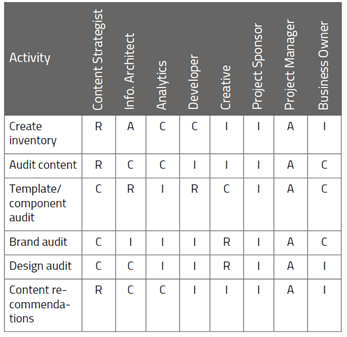Content inventories and content audits are two of the most important tools of content strategy. Without them, a content strategy is not only incomplete, but cannot be carried out methodically at all. Paula Land's book is a comprehensive introduction to these tools. At the same time it is a handbook that provides basic knowledge about the most important forms of content inventories and audits. Every professional content strategist should know this book.

The book is structured into 3 separate sections:
- Section I: Laying the groundwork
- Section II: Building and Delivering the Audit
- Section III: Inventory and Audit Resources
What are inventories and content audits?
Content audits and inventories are methods of analyzing content from two different perspectives. While the content inventory provides quantitative insights, the content audit provides qualitative insights for a set of content. Both analyses are often part of a larger content improvement project or ongoing maintenance.
Paula Land walks the readers through every step of the process of doing an inventory and audit. She looks at aspects like putting together a project, assembling a team, and setting goals. She shows different methodologies for auditing and also gives some advice on presenting the findings to stakeholders.
Laying the groundwork for a content audit project
Diana Railton, who wrote the foreword to this book, compared the process of conducting a content audit and inventory with a visit to the dentist. She explains that even though we know that regular check-ups are important, we are afraid of the painful treatment and the high costs. But just like a regular check at the dentist, content inventories and audits pay off in the end. She goes on to explain that with the help of a content audit, problems can be caught while they are smaller and ultimately, stress is reduced. Paula Land starts her book with the explanation that inventory and audit projects must be based on a solid business case. In the first chapter, the author talks about the improvement framework "DMAIC" which is an acronym for define, measure, analyze, improve, and control. The book focuses on the first three aspects of the framework define, measure, and analyze.
In the define phase, content goals are established. The measure phase is where the content inventory is conducted. The analysis phase is where the content is audited.
According to the author, the advantages of carrying out an inventory are the
- assessment of site details and the content set
- estimation of resources
- identification of patterns in content structure
- development of measures (return on investment)
- establishing of the basis for tracking
The content audit, on the other hand, helps with
- assessing the content's current state
- evaluating whether content follows consistent rules
- evaluating whether content supports business goals
- preparing content for revision
- developing understanding of content
Every content strategy project has constraints. To achieve desired outcomes despite limited resources, a project plan should be put together. Visions and goals should be documented, and the responsibilities should be defined. The author goes into details about how to put together a team for a content strategy project. A lot of people can be involved in a project like this. Therefore it is important to set roles and responsibilities and distribute the workload appropriately. Paula Land recommends using the RACI Matrix. It describes who is responsible, accountable, consulted, and informed in a project.

Creating a content inventory
A content inventory is a representation of website data that is often presented in the form of a spreadsheet. At a minimum, it should contain a list of all files on the website (HTML pages, images, documents, media). Additional data like keywords, description, meta title, and word count are helpful to further analyze the site quality. An inventory can be carried out automated or manually and helps to understand the site structure and content patterns.
The basic elements of a content inventory include
- URL
- Type
- Metadata
- Publication date
- File Size
- Analytics data
- Links in and out
- Word count
Inventories should function as a starting point to scope out audit efforts. They are a way of collecting valuable information about the current content situation. Understanding the starting condition of the content is an important step to be able to dive deeper into der content audit and to come up with insightful recommendations.
Preparing for a content audit
Once the inventory is prepared the audit process can begin. However, beforehand it is crucial to decide what to audit and to dive deep into the business context. This means choosing criteria to measure the content against while keeping goals, audiences, timelines, and budget in mind. Paula Land mentions Rahel Bailie's method of auditing, the RAITES METHOD (relevant, accurate, informative, timely, engaging, standard-based) as one possible method for the audit.
According to Paula Land, there are many more important factors to consider before auditing. These factors include business requirements, project limits, project timeframes, and project types. Typically, a content audit could be part of one of the following scenarios
- Content strategy initiative
- Website redesign
- CMS implementation
- Global market roll-out
- Governance initiative
- Ongoing maintenance
The type of project can influence the scope and criteria of the content audit. A content strategy initiative or a website redesign may require a different amount of information than an ongoing maintenance project.
The following part of Paula Land's book lays out how to conduct an audit. She points out several perspectives such as auditing for content effectiveness, competition, global or legal issues.
The multichannel audit
When taking a closer look at the audit process in general it is often revealed that content usually gets published on many different platforms. Since multichannel publishing has become the gold standard, it is important to keep a comprehensive approach from the beginning to avoid content being overlooked.
Unless a company has carefully managed its social presence, identifying all of the channels to which the company publishes, often takes investigating through different departments to gather all the important data.
The process of auditing across multiple publishing channels doesn't differ tremendously from auditing a single channel. The same key criteria such as consistency, accuracy, tone of voice, and quality can be applied, although the target audiences and communication goals might vary from channel to channel.
Paula Ladenburg Land suggests that a good list of data to start building an audit includes these:
- Network name
- URL of the page or profile
- Type of content being shared
- Any visible metrics (likes, shares, followers)
- Audience
- Business owner
Taking a look at the social media channels is crucial to get the full scope of the content strategy of a company since it often happens that the online presence is not fully in line with business and content strategy.
To sufficiently reach the communication goal of the company it is also important to take a look at how well the social network's presence is integrated on other publication channels and how encouraging it is to engage with them.
Since most of the websites serve multiple audiences, to take a more in-depth look from different points of view, creating personas offers a valuable framework against which content can be measured. A persona is described as a fictional person who represents a major user group for your site (Usability.gov)
The basic specifications of a persona often include personal data, family circumstances, geographic location, demographics such as age, occupation, income, and if relevant ethnicities as well as more personal information such as needs, behaviors, and motivation. Combining customer journey maps and personas provides a deeper level of understanding of how and where users interact with content.
As Paula Ladenburg Land points out in her book "Every time a user comes to your website, you are given an opportunity to convey information, inspire trust and loyalty to the brand, make a sale, or otherwise engage the user".
But what makes good content?
Paula Ladenburg Land offers a variety of questions to ask and criteria to measure the quality of content. She focuses on the questions of whether the content is:
- relevant
- current
- accurate
- engaging
- easy to read
- audience-appropriate
- consistent
- on-message
- supportive of user tasks
- sufficiently broad and deep
- appropriately presented
Which criteria are chosen to audit content against, are dependant on the communication goals of a company. To ensure that content has high quality and provides a consistent reading experience, some ground rules can often be found in the form of brand guidelines. The tone of voice can still vary within those guidelines from section to section. Paula Ladenburg Land points out that blogs will very likely have a different tone of voice as legal content for example.
When auditing for content effectiveness, which data is most meaningful and which tool is best to use can vary from project to project. In general, there is a clear distinction between "hard" metrics such as conversions, time spent on site, number of visits, and "soft" metrics such as behavioral analysis and customer satisfaction surveys. To get a better understanding of where the focus of the audit should be, Paula Ladenburg Land suggests to take a closer look at the highest and lowest performing pages as a first step.
Auditing for a global content project comes with its own set of challenges such as managing different languages, global navigation, global consistency, and localization. Although not every business requires to be present across the globe, if they do, translating content without losing consistency and accuracy often needs a little bit more effort and careful consideration. Cultural differences such as varying terminology, the different significance in colors, icons, and images should also play into account when auditing for a global content project.
Paula Ladenburg Land also gives an insight into the process of conducting an audit for legal issues. She underlines that a comprehensive audit must include a pass through the content for trademarks, terms of use, copyrights, privacy policies, and other legal or regulatory issues.
Presenting audit findings
As an outline, Paula Ladenburg Land states "A content audit presentation should tell the story of what you found, both in summary and in detail". To give a guideline, she also suggests some audit presentation essentials:
- Summarizing the current state
- Describing the future state
- Analyzing the gap between current and desired states
- Discussing risks and opportunities
- Providing next steps to recommendations
But as Paula Ladenburg Land expresses throughout the book, the audit shouldn't end there. Since websites are constantly changing and evolving, in the best case, a content audit is an ongoing process and plays an important role in the website's content governance process.
Where to go from here #
References #
Land, P. L. (2014). Content audits and inventories: A handbook. Laguna Hills : XML Press Ibswich, Mass. : EBSCO Publ. http://public.ebookcentral.proquest.com/choice/publicfullrecord.aspx?p=181052
Land, P. L. (2023). Content Audits and Inventories: A Handbook for Content Analysis (2nd edition). XML Press.
Sperano, I. (2017). Notes de lecture: Paula Ladenburg Land, Content Audits and Inventories. Interfaces numériques, 4(2), 310–310. https://www.unilim.fr/interfaces-numeriques/index.php?id=625

